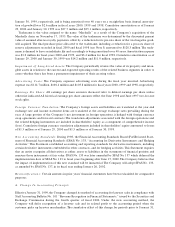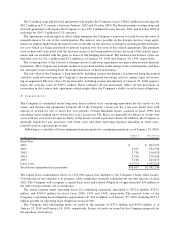TJ Maxx 1999 Annual Report Download - page 18
Download and view the complete annual report
Please find page 18 of the 1999 TJ Maxx annual report below. You can navigate through the pages in the report by either clicking on the pages listed below, or by using the keyword search tool below to find specific information within the annual report.
For measurement purposes of the postretirement medical plan, a 3.77% annual rate of increase in the per
capita cost of covered health care benefits was assumed and is gradually reduced to zero.The impact of medical
inflation eventually diminishes because of the $3,000 per capita annual limit on medical benefits.An increase in
the assumed health care cost trend rate of one percentage point for all future years would increase the accumu-
lated postretirement benefit obligation at January 29, 2000 by about $868,000 and the total of the service cost
and interest cost components of net periodic postretirement cost for fiscal 2000, by about $151,000. Similarly,
decreasing the trend rate by one percentage point for all future years would decrease the accumulated postre-
tirement benefit obligation at January 29, 2000 by about $826,000 as well as the total of the service cost and
interest cost components of net periodic postretirement cost for fiscal 2000, by about $145,000.
Following are the components of net periodic benefit cost:
Pe n s i o n Po s t re t i r e m e n t Me dical
Fisca l Ye a r E nde d Fis ca l Ye a r En de d
Jan u a r y 2 9, Janu ary 3 0 , Janu a ry 3 1, Jan u a ry 2 9, Ja n u a ry 30, Ja n u a ry 31,
I n Th o u s a n d s 2 0 0 0 1 9 9 9 1 9 9 8 2 0 0 0 1 9 9 9 1 9 9 8
Service cost $ 11,781 $10,538 $ 8,372 $1,366 $1,405 $1,366
Interest cost 10,768 9,647 8,398 1,430 1,610 1,649
Expected return on plan assets (11,060) (9,991) (7,937) –– –
Amortization of transition obligation 75 75 75 –– –
Amortization of prior service cost 87 87 837 332 338 749
Recognized actuarial losses 415 2,702 206 –103 –
Net periodic benefit cost $ 12,066 $13,058 $ 9,951 $3,128 $3,456 $3,764
During the fiscal year ended January 29, 2000, the Company and its then Chief Executive Officer entered into
an agreement whereby the executive waived his right to benefits under the Company’s nonqualified plan in
exchange for the Company’s funding of a split-dollar life insurance policy. The exchange was accounted for as a
settlement and the Company incurred a $1.5 million settlement loss, which is primarily the recognition of a
portion of the deferred losses under the plan.The benefit exchange was designed so that the after-tax cash expen-
d i t u res by the Company on the split-dollar policy are substantially equivalent on a present value basis to the
a f t e r-tax cash expenditures the Company would have incurred under the nonqualified plan.
The Company also sponsors an employee savings plan under Section 401(k) of the Internal Revenue Code
for all eligible U.S. employees. Employees may contribute up to 15% of eligible pay. The Company matches
employee contributions, up to 5% of eligible pay, at rates ranging from 25% to 50% based upon Company
performance. The Company contributed, for all 401(k) plans, $6.2 million in fiscal 2000, $6.4 million in fiscal
1999 and $5.7 million in fiscal 1998.
In the fourth quarter of fiscal 1999, the Company established a nonqualified savings plan for certain U.S.
employees.The Company matches employee contributions at various rates which amounted to $634,000 in fiscal
2000 and $210,000 in fiscal 1999. The Company transfers employee withholdings and the related company
match to a separate trust designated to fund the future obligations. The Company includes the trust assets in
other assets on the balance sheets.
In addition to the plans described above, the Company also maintains retirement/deferred savings plans for
all eligible associates at its foreign subsidiaries. The Company contributed for these plans $682,000, $534,000
and $440,000 in fiscal years 2000, 1999 and 1998, respectively.
























